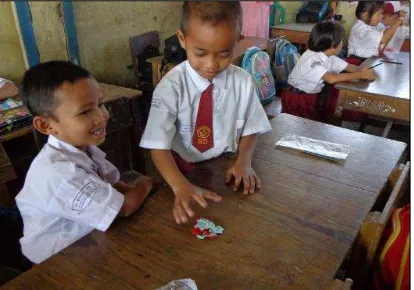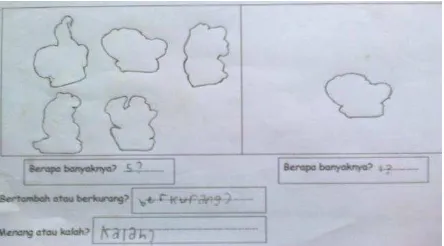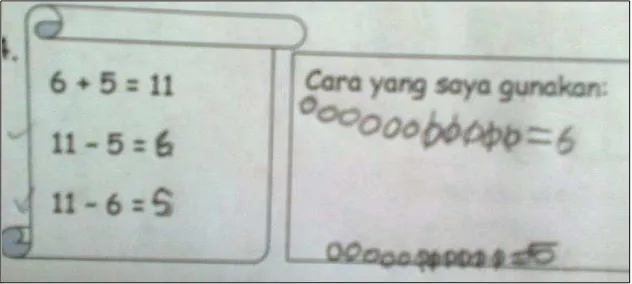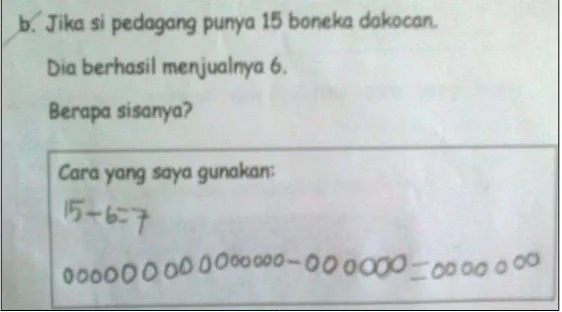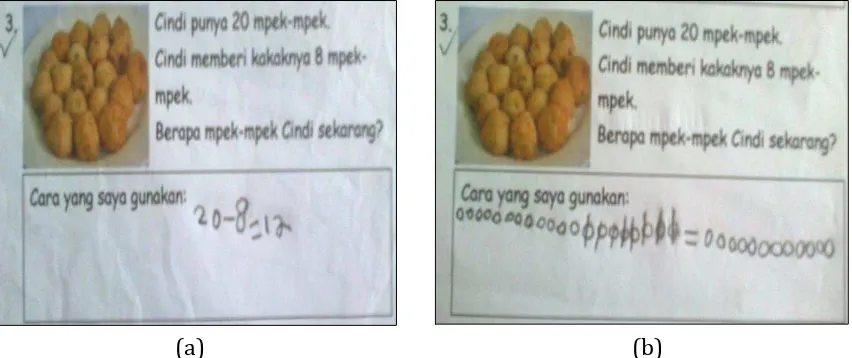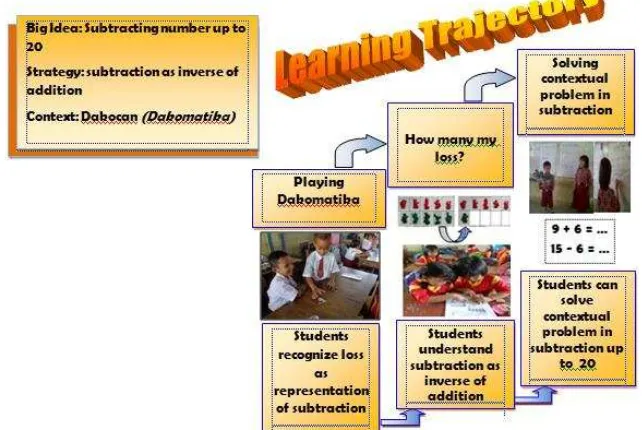INSTRUCTIONAL DESIGN OF SUBTRACTION USING PMRI APPROACH
BASED ON TRADITIONAL GAME
Farida Nursyahidah1, Ratu Ilma Indra Putri2, Somakim2
University of PGRI Semarang1
Sriwijaya University2
fan_sya@yahoo.co.id1
ABSTRACT
The purpose of this study is to know the students’ understanding in subtracting number up to 20 using Pendidikan Matematika Realistik Indonesia (PMRI) based on traditional game of dakocan and to acquire a learning trajectory of subtracting number up to 20 that develops from informal to formal level at the first grade of primary school. This research used design research that consists of three phases: preliminary design, teaching experiment, and retrospective analysis. This research was conducted in primary school of 98 Palembang as one of partners’ school of PMRI. The result of this research shows that the students’ understanding in subtracting number up to 20 could be stimulated by using traditional game of dakocan as a context. All the activities done by students produce learning trajectory to gain the goal of learning. That also could be shown through all of strategies and model used by students and also their result discussion. Each step of learning trajectory using dakocan produced consists of playing dakocan, putting the model of dakocan to know how many my losses, and solving contextual problem in subtracting number up to 20.
Key Words: PMRI, Subtraction, Dakocan
INTRODUCTION
Learning numbers on primary level to be important for learning other topics (NCTM, 2000). Therefore learning numbers becomes one prerequisite for learning mathematical knowledge on another topic. Subtraction numbers up to 20 is taught in the first grade of primary school in odd semester.
Based on some of the research results, students’ problems encountered in learning of subtraction numbers are teachers directly use formal mathematics. Meanwhile, according Gravemaijer (1994), mathematics is not just a matter that is transferred by the teacher to the student, but actively engaging students to reinvent the mathematical concepts in their own way. Learning mathematics appropriate and oriented matematisize everyday experience is PMRI.
Some research on PMRI involving a traditional games give the results that the use of traditional games as a context for learning provides many benefits to learning mathematics more meaningful, fun, and can develop students' understanding of mathematical concepts learned (Nasrullah, 2011; Jaelani , 2012; Charitas, 2012). A line with this, Zulkardi and Putri (2006) states that the context becomes the first step in learning mathematics. This is also confirmed by Somakim (2008), that by integrating games into the learning process, it is also give condition to the students learn while playing so that students become active and excited in learning. One of the traditional games that can be used as a context in subtraction number up to 20 is dakocan.
Based on the color, shape, and the rules of that game which resulted in winning and losing, as well as the song and motion, traditional game of dakocan can be used as a starting point to teach the concept of subtraction number up to 20 in first grade elementary school. This game can be integrated with other subjects in the thematic learning. The research question of this study is how the students' understanding of the concept of subtraction number up to 20 using dakocan and how students’ learning trajectory evolved from the informal to the formal level?
THEORITICAL FRAMEWORK Subtraction Numbers
Freudenthal (1991) believes that counting is the first mathematical verbal form of the children. Structuring in learning numbers when doing subtraction are preferable because if the child already has the ability to structure numbers, the operational capabilitiesin the calculation can they have by themselves (Traffers, 2001 in Collins & Wright, 2009). Thus, this capability is expected to help them in learning subtraction of numbers.
In the RME learning, there are three principles proposed by Gravemeijer (1994), among others: (1) guided reinvention and progressive mathematizing, (2) didactical phenomenology, and (3) self-developed models. Furthermore, there are five characteristics of realistic mathematics education, they are: (1) The use of context, (2) The use of models, (3) Student contributions, (4) Interactivity, (5) Intertwining (Gravemeijer, 1994).
Traditional Game of Dakocan
Dakocan is one of popular traditional game in Palembang. This game is similar to the
type of game in Bangka, just different names and the tools used, it is Jelentik. According to the Department of Education (1985), Jelentik is a game that is usually done by children who are in school or have not aimed to train children to know about counting number.
Furthermore, it should be known that in this dakocan game does not involve bet or any currencies. Determination win or lose in this game is if the number of dakocan at the end of the game increase means wins, and vice versa, if the number of dakocan in the final game reduced means lose. In this case, losing in this game could be associated with the basic concepts of subtraction.
METHOD
The method used in this study is design research. The aim of design research is to formulate Hypothetical Learning Trajectory (HLT) which can be elaborated and refined during the research process (Gravemeijer & Cobb, 2006). The stages are carried out in this study is the preparation (preliminary design), experimental research (teaching experiment), and retrospective analysis. The subjects were involved in this study were 33 first grade students of state primary school of 98 Palembang, South Sumatra, Indonesia.
RESULT AND DISCUSSION
Based on the research that has been done, the results showed that students' understanding of the concept of subtraction number up to 20 can be supported on some activities that are playing dakocan, put dakocan models to determine how many my loss, and solve contextual problems related to subtraction. As well as students' learning trajectory can be generated from the informal to the formal level. Furthermore, the results and discussion on the matter can be described as follows.
Student Understanding the Concept of Subtraction Number up to 20
Students' understanding the concept of subtraction number up to 20 using dakocan can be described as follows.
Students can Understand Concept of Subtraction Number Through Playing Dakocan
Students perform dakocan game with each group in pairs with 5 dakocan at the beginning. But before it, there were two students who voluntarily simulate playing in front of the class with 3 dakocan at the beginning. Furthermore, through activities play
loss and describe their own dakocan models. Students may find that losing is decreasing
dakocan event from the previous number of dakocan that got from subtraction some
dakocan originally belonged to his opponent. Furthermore, teachers explore the game
results to guide students find the concept of subtraction number. The students' understanding of the concept subtraction can be seen from the interviews of teachers and students as follows.
Teacher: "Who lost?" Student: "Aditya"
Teacher: "Why did Aditya lose?" Meyla : "his dakocan ran out"
Teacher: "if someone lost his dakocan, increased or decreased?" Student: "decreased"
Based on the transcript above, students understood that losing as reduced event of which is a representation of subtraction. This will help students to understand the results of playing dakocan that they play with each pair. Furthermore, the activity of the students while playing dakocan with each group can be seen in Figure 1.
Figure 1. The students playing dakocan
Furthermore, the teacher held a class discussion about the game that has been done by each student. For example, for one group of students who played obtain the result 8-2, with Rio as the winner and Andi loss. Each results obtained by students in playing
dakocan can help them to find the concept of reduced items (dakocan) as subtraction
through the guidance of the teacher.
Then the teachers share My Dakocan Picture Activity Sheet. By describing dakocan individually before and after playing could help the students understand events decreases as subtraction and could determine how many my losses, by comparing the two. In addition, the drawing can stimulate their creativity and ability to create patterns that can be observed from the picture. Basically the kids were happy with the drawing activity, so they were excited to do so. Furthermore, students' creativity in drawing
Figure 2. The example of loss case
According to Figure 2, it can be seen that students were able to model dakocan in the form of images, see dakocan drawn as representations of number and was able to calculate the number, as well as being able to compare before with after playing
dakocan, which originally had 5 dakocan after playing there were 1 dakocan. Students
were able to determine that his dakocan reduced and loss that is a representation of subtraction concept.
After students have found the concept of subtraction is a reduction of an item from its original state, through the students activity sheet, students were given a more general problem, namely the case of the results of other people's game. It was intended to sharpen the students' understanding of a particular case to the public. In this case the student could answer the questions, so that indicates they were able to understand the concept of subtraction. Students still had difficulties writing the answers since they are still learning to write. But this problem can be given a solution, through the guidance of the teacher to write the answer by telling letters forming the word in question.
Students can Understand Subtraction Number Through Activity Put Dakocan Model to Know How Many My Loss
Through these activities, students can understand the concept of subtraction from the results of playing dakomatika who lost and they can progress towards a strategy to solve the problem of the subtraction number up to 20. Teachers provided apperception questions in the form of question and answer with students about the problems of their loss. The teacher gave students activity sheet about how many my loss to be done in groups. After students discussed all the results, the teacher facilitated the students for presentation to the class and in the classical discussion with the teacher guide.
(a) (b)
Figure 3. Examples of student’s correct answer left and incorrect answer right
For the question of subtraction number 4 on the students activity sheet, majority of students were able to do it correctly. Most of them were able to use subtraction is the inverse of addition strategies; interestingly there were some groups that still used symbol in the form of a circle. They made circles known as the problem; they crossed out part as many as stated in that question. For example, 11-5, they make as many as 11 then crossed five circles, and then calculated the sphere is still intact or has not crossed as the rest that is 6. So they answered 11-5 = 6. Similar to about 11-6 = 5, they used the same strategy. Examples of student work can be seen in Figure 4.
Figure 4. The Example of Students Work in Subtraction
Students can Solve Contextual Problem in Subtraction Number up to 20
Students can understand the concept of subtraction number that further can be applied to solve contextual problems related with subtraction number up to 20. Through early activity is a question and answer orally problems in daily life related to subtraction to construct the ability of students in solving problem, although initially they still counting using fingers. Furthermore, the form of question and answer between the teacher and the student indicating that the student was able to solve contextual problems related subtraction through the activity playing the role of "buying and selling dolls" are as follows.
Student: "11"
Teacher: "Good, then purchased by Rina 4, how many dolls of Ardiansyah now?" Looks students count Ardiansyah’s doll.
Khofifah: "7"
Teacher: "Well, how do you get it?" Student: "Reduced"
Teacher: "Well, you guys are good" (teacher gives reinforcement)
The next activities construct the students' ability in solving contextual problem by doing on some problems in students’ activity sheet in groups. They learn to read about and understand the guidance of the teacher. The role of the teacher in this session is limited to helping read about when there were students who cannot read. Furthermore, they will determine how to solve the problem at the students’ activity sheet by their own.
The students looked very enthusiastic in communicating their opinions during the discussions with the group and then wrote the results on Students Activity Sheet. After completing discussion, students presented the results of their discussion to the class and other groups responded with a teacher guide. Students were very excited about the presentation in front of the class, because they could learn to communicate their opinions and discuss it classically.
Based on the classical discussions, it is known that some students could understand the problem in question and then were able to finish it. To indicate that students understand the problem is if they can write contextual problem in a matter of sentences into mathematical form and finish with their strategies, either using concrete objects or with the help of free symbols in the form of circles. In addition, it is found tha students still made mistakes in doing subtraction problems. As an example of student work on the subtraction of the problem can be seen in Figure 5.
Figure 5. The example of incorrect student’s work
usually used symbols or lines, crossed out circle, not align. However, in the class discussion, students could realize their own mistake and can know the truth.
Other contextual problems related to the subtraction number up to 20 as also contained in Question on the students’ worksheet. There were some students who used the formal stage solution that is directly using mathematical sentences and there were groups of students who were still using a symbol in the form of circles along with cross out because of the subtraction strategy. Furthermore, they counted the number of dots that were still intact, and then it was the result. An example of the students' work can be shown in Figure 6.
(a) (b)
Figure 6 (a) Example of the group works of Cindi and Masayu; (b) Example of the group works of Aan and Aditia
After carrying out activities that were designed and performed well in group discussions and classical in solving some contextual problems that exist in the Students’ Worksheet, it was known that students could understand the concept of subtraction number up to 20 and could apply it to solve contextual problems. Therefore, this activity could support students' understanding of the concept of subtraction number up to 20 and ability of solving contextual problems.
Learning Trajectory of Students in Subtraction Number up to 20
Figure 7. Learning Trajectory of Subtraction Number up to 20
CONCLUSION
Conclusion of this study is the design of learning using traditional game of dakocan can help students find their own concept of subtraction number up to 20. Learning using dakocan with PMRI approach can stimulate students' understanding of the subtraction number, subtraction as invers of addition, and solve the contextual problem related to subtraction number up to 20. Learning trajectory that has been produced can support students' thinking strategies in subtraction number consists of playing dakocan, counting my loss, and solving problem related to the subtraction number up to 20.
REFERENCES
Armanto, D. (2002). Teaching Multiplication and Division Realistically in Indonesian
Primary Schools: A Prototype of Local Instructional Theory. University Twente,
Enschede: Doctoral dissertation.
Charitas, R. (2012). Learning Multiplication Using Indonesian Traditional game in Third Grade.IndoMS. J.M.E. Vol. 3 No. 2 July 2012, pp. 115-132. in press.
Collins, D. E., & Wright, R. (2009). Structuring Numbers 1 to 20: Developing Facile Addition and Subtraction. Mathematics Education Research Journal. Vol 21, No 2, pp. 50-75.
Depdikbud. (1985). Permainan Anak-anak Daerah Sumsel. Palembang: Depdikbud.
Freudenthal, H. (1991). Revisiting Mathematics Education: China Lectures. Dordecht, the Netherlads: Kluwer Academics Publisher.
Gravemeijer, K. (1994). Developing Realistic Mathematics Education. Utrecht: Technipress, Culemborg.
Gravemeijer, K. & Cobb, P. (2006). Design research from the learning design perspective.
Educational Design Research (pp. 17-51). London: Routledge.
Murdiyani, N.M. (2012). Developing a Model to Support Students in Solving Subtraction.
IndoMS. J.M.E. Vol. 4 No.1 Januari 2013, pp. 95-112.
Nasrullah., Zulkardi. (2011). Building counting by traditional game: A Mathematics Program for Young Children.IndoMS. J.M.E. Vol. 2 No. 1 January 2011, pp. 41-54.
National Council of Teacher of Mathematics.(2000). Principles and Standards for School
Mathematics. USA : NCTM.
Somakim. (2008). Unit 2: TeoriBelajarDienes. In NyimasAisyah, dkk.BahanajarCetak:
Pengembangan Pembelajaran Matematika Sekolah Dasar, (pp. 2-1 – 2-42).
Direktorat Jendral Pendidikan Tinggi: Departemen Pendidikan Nasional.
Thompson, I. (1999). Mental Calculation Strategies for Addition and Subtraction. Leicester: The Mathematical Association.
Vilette, B. (2002). Do young children grasp the inverse relationship between addition and subtraction? Evidence against early arithmetic. Cognitive Development, 17, 1365–1383.
Zulkardi. (2002). Developing a Learning Environment on Realistic Mathematics Education for Indonesian Student Teachers. Thesis University of Twente. The Netherlands:
PrinPartners Ipskamp-Enschede.
[http://doc.utwente.nl/58718/1/thesis_Zulkardi.pdf]
Zulkardi & Putri, R.I.I. (2006). Mendesain Sendiri Soal Kontekstual Matematika.
